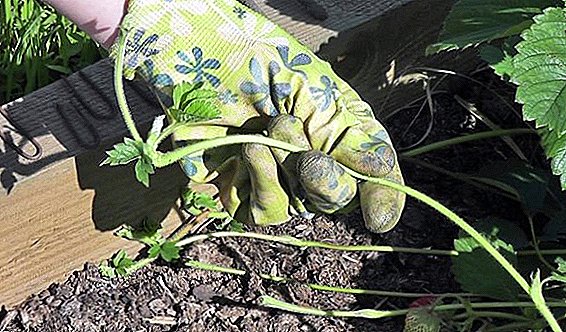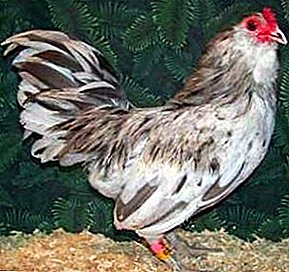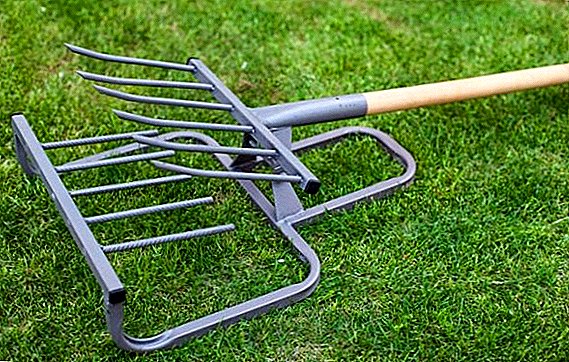 The beginning of the summer season is not only rest, but also a lot of work in the garden. Each summer resident tries to make the task of tillage as easy as possible, for which different equipment is used. Recently, the wonder-shovel, which can be made by hand, has gained wide popularity.
The beginning of the summer season is not only rest, but also a lot of work in the garden. Each summer resident tries to make the task of tillage as easy as possible, for which different equipment is used. Recently, the wonder-shovel, which can be made by hand, has gained wide popularity.
Miracle Spade: what is it
 The classic version of the miracle shovel is the bayonet shovel, which allows to process the soil of any complexity. Such a tool is a combination of forks and sleds, thanks to which it is much easier to plow the soil. Of course, it is much easier to use tillers, electric cultivators or ask for help from a tractor driver, whose machine is equipped with a plow. Nevertheless, all these actions will require quite substantial material costs from you, which is why most gardeners still prefer to work with their hands.
The classic version of the miracle shovel is the bayonet shovel, which allows to process the soil of any complexity. Such a tool is a combination of forks and sleds, thanks to which it is much easier to plow the soil. Of course, it is much easier to use tillers, electric cultivators or ask for help from a tractor driver, whose machine is equipped with a plow. Nevertheless, all these actions will require quite substantial material costs from you, which is why most gardeners still prefer to work with their hands.
What is so remarkable miracle shovel? The sharp teeth of the super-shovel easily enter the ground, and thanks to the lever (represented as a long handle) you can lift large pieces of soil, which will be loosened on the second part of the forks on the surface.
Based on the depth of loosening and the presence of additional elements, all such devices can be divided into three types: common, type "plowman" and type "mole".
Conventional shovels in most cases are made at home and consist of a fork and a backstop. When using such a tool, you can actually reduce the load and increase the speed of work, but such a shovel will not solve the problem with large blocks of earth. It is only suitable for working on regularly treated black soil.
 Wonderful shovel type "plowman" is not only for digging the ground, but also for better soil loosening. The length of its bayonet is usually 10-15 cm, which makes it easy to undress any type of soil, and the bayonet quietly goes into the ground, even if the weight of the worker is no more than 60 kg.
Wonderful shovel type "plowman" is not only for digging the ground, but also for better soil loosening. The length of its bayonet is usually 10-15 cm, which makes it easy to undress any type of soil, and the bayonet quietly goes into the ground, even if the weight of the worker is no more than 60 kg.
The depth of the bayonet spade bayonet is not less than 25 cm and is intended for deep digging. Potholes are immediately used for planting vegetables. In the case of the use of this particular tool, a digger will require some effort, especially if you have to work on compacted soil or alumina.
Important! In addition to the described variants of miracle shovels, there are also universal options, the bayonet length of which is from 15 to 20 cm. They are excellent for regions where the soil can freeze by 5-10 cm, and the main type of soil is chernozem (burozem).If the climatic conditions of the region are even more severe, even such a depth of shovels bayonet will not be enough, and you will not be able to update the soil qualitatively.
How to dig a miracle shovel? We note the convenience of its use: you will not need to bend over, and the risk of injury to your back is minimized (this is especially true for people with radiculitis). Also, the required physical effort decreases, and the speed of work, on the contrary, increases. The procedure for working with an improved shovel is as follows.
 Pressing the foot on a special platform, it is necessary to deepen the shovel into the ground. Without removing your foot from the platform, take a second step backward, while simultaneously tilting the spade at yourself - the ground will be on the teeth. Light shakes of the left and right hand shake off the soil, thus carrying out loosening. It is possible to turn the ground by one sharp movement of the hand upwards, sliding the shovel 10-15 cm back. After completing several approaches, you need to walk around the site with a rake and break up clods.
Pressing the foot on a special platform, it is necessary to deepen the shovel into the ground. Without removing your foot from the platform, take a second step backward, while simultaneously tilting the spade at yourself - the ground will be on the teeth. Light shakes of the left and right hand shake off the soil, thus carrying out loosening. It is possible to turn the ground by one sharp movement of the hand upwards, sliding the shovel 10-15 cm back. After completing several approaches, you need to walk around the site with a rake and break up clods.
Did you know? The outdated name of the modern shovel is “spade”. It comes from the definition of the type of action "to intervene, to advance with the foot," that is, to press a metal bayonet.
In factory models of shovels, moving parts are often clogged with earth, which is why they start to work worse. In addition, sometimes broken and wooden handles, which are inserted into special slots. In self-made tools, all parts are connected quite rigidly, so that breakages and sticking are almost completely excluded. However, this does not mean that the miracle shovel for the garden, which was made by hand, is completely devoid of flaws. There is a serious possibility of deformation of the joints of soldering or welding and breakage of plastic parts (if they exist), although such faults appear only after many years of active use.
Wonderful spade do it yourself that we need
 There are several important points that you should pay attention to when making a miracle shovel. The length of the bayonet to which it will enter the soil depends on the depth of soil freezing. In those cases where the use of a shovel is necessary only for loosening the soil, 10 cm will be enough, but for planting vegetable crops it will be necessary to perform a deeper digging (at least, the teeth should go into the frozen soil layer by 5 cm). The width of the future miracle shovel depends on the intended land grab area.
There are several important points that you should pay attention to when making a miracle shovel. The length of the bayonet to which it will enter the soil depends on the depth of soil freezing. In those cases where the use of a shovel is necessary only for loosening the soil, 10 cm will be enough, but for planting vegetable crops it will be necessary to perform a deeper digging (at least, the teeth should go into the frozen soil layer by 5 cm). The width of the future miracle shovel depends on the intended land grab area.
Important!The width of the tool should not exceed 50 cm, otherwise you will need to exert too much effort.Selecting the necessary materials to create your own miracle shovels, you need to remember that industrial models are based on the use of forks, but not the usual double or trident, but wider (from 35 cm). When the step between the working rods formed about 5 cm, which is seven teeth in the length of a quarter meter. It is clear that this is not the whole miracle shovel, and the drawing, which will be presented below, shows many other, equally important details.
So, To create this tool with your own hands, you will need:
- rebar or doped flat steel with a width of 2 cm and a cross section of about 0.5 cm;
- square tube with a section of 1 cm;
- metal pipe with a diameter greater than 5 cm;
- welding machine;
- bolts and nuts;
- Bulgarian;
- drill;
- sandpaper.
Did you know? The name of the person who invented the miracle shovel is not known for sure, although it is believed that it was developed in Yekaterinburg.
Instructions for making wonderful shovels with drawings
Before embarking on the independent production of the miracle shovels, it is necessary to pay attention to the basic structural features of such a tool. In most models, the forks are mounted movably on a frame pushed forward and placed horizontally, complemented by a stop at the rear (in some cases, the frame is replaced with a slightly curved sled). Between the teeth, counter-rods are missed, which more closely resemble a rake.
The tool can have two handles, but in most cases it is a regular handle, like a shovel or the same fork. However, not in all cases a wooden handle is used, since such a lever can easily break (the teeth often cling to the roots). Instead of a cutting metal pipe (for example, aluminum) can be installed. If the wooden handle breaks in the nest of the garden tool, at its very foundation, then it will be quite difficult to remove the debris, and the only way out is to try to drill it out.
There are more simplified models, the design of which includes only the frame, which is simultaneously an emphasis (located behind the working part). The teeth are fixed directly to the front rod, at the ends of which are fasteners for the other two handles. This version of the miracle shovel is most often made at home.
Did you know? In the old days, the standard wooden shovel (or, as it was also called, “blade”) had a width of 6-14 inches and a length of 8-16 inches, and this with a total length with a handle 1½-1¾ arshin. In Russia, all shovels and blades were hewn mostly from aspen, sometimes from linden or birch, and even more rarely from oak or maple.
When self-manufacturing the miracle shovels, first of all, it is necessary to create bayonets, for which purpose the reinforcement prepared in advance is cut into pieces of the required length. The ends of these segments are sharpened from one side at an angle of 30 °, although if the soil in your area is soft, the bevel angle can be reduced to 15 ° (although this will lead to frequent blunting of the cutting part).
Having the required bayonets on your hands, you can proceed to the creation of a carrier bar, for which part of the square tube is cut off. It is also worth preparing a round hollow tube, which in the future will play the role of a handle. All elements are welded according to the drawings presented below.


Advantages and disadvantages of using a miracle shovel in the garden
So, we have already figured out how to make a miracle shovel yourself, and what you might need for that. But is this tool necessary in the household? It is necessary to consider all the advantages and disadvantages of this design.
Miracle shovel is much more convenient to use than its other counterparts, because it:
- helps to reduce physical exertion;
- increases the speed of digging due to the width of the channel;
- very easy to use;
- suitable for use on any soil;
- possesses a high indicator of reliability.
There are also design flaws, including the following:
- the complexity of the repair activities;
- the inability to figure digging;
- the impossibility of digging holes;
- for productive work, the weight of the digger should not be less than 80 kg.
 The tool is just perfect for arable work. Based on the length of the bayonets on the main forks, the pothole is used either for loosening the soil or for sowing. So, a depth of 15-25 cm (exact figures depend on the level of soil freezing) will be quite enough for planting potatoes, cabbage, corn and most vegetable crops. However, given that tomatoes, peppers and cucumbers are planted immediately by seedlings, they will have to manually create separate holes. In the garden, a miracle shovel will be useless: it is not suitable for planting trees and creating neat holes.
The tool is just perfect for arable work. Based on the length of the bayonets on the main forks, the pothole is used either for loosening the soil or for sowing. So, a depth of 15-25 cm (exact figures depend on the level of soil freezing) will be quite enough for planting potatoes, cabbage, corn and most vegetable crops. However, given that tomatoes, peppers and cucumbers are planted immediately by seedlings, they will have to manually create separate holes. In the garden, a miracle shovel will be useless: it is not suitable for planting trees and creating neat holes.
Summarizing all the above, it should be noted that such equipment will definitely be useful to owners of vegetable gardens used for growing vegetables, and the area to be treated should not be less than half a hundred, otherwise it will be easier to do the work with a regular shovel.












